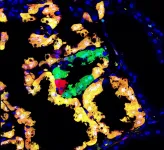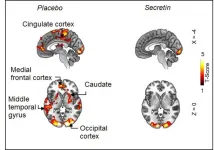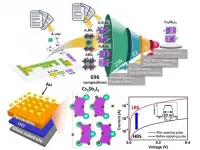Tree pollen carries SARS-CoV-2 particles farther, facilitates virus spread
Computer model recreates a willow tree and nearby crowd to provide new perspective on social distancing measures
2021-06-22
(Press-News.org) WASHINGTON, June 22, 2020 -- Most models explaining how viruses are transmitted focus on viral particles escaping one person to infect a nearby person. A study on the role of microscopic particles in how viruses are transmitted suggests pollen is nothing to sneeze at.
In Physics of Fluids, by AIP Publishing, Talib Dbouk and Dimitris Drikakis investigate how pollen facilitates the spread of an RNA virus like the COVID-19 virus. The study draws on cutting-edge computational approaches for analyzing fluid dynamics to mimic the pollen movement from a willow tree, a prototypical pollen emitter. Airborne pollen grains contribute to the spread of airborne viruses, especially in crowded environments.
"To our knowledge, this is the first time we show through modeling and simulation how airborne pollen micrograins are transported in a light breeze, contributing to airborne virus transmission in crowds outdoors," Drikakis said.
The researchers noticed a correlation between COVID-19 infection rates and the pollen concentration on the National Allergy Map. Each pollen grain can carry hundreds of virus particles at a time. Trees alone can put 1,500 grains per cubic meter into the air on heavy days.
The researchers set to work by creating all the pollen-producing parts of their computational willow tree. They simulated outdoor gatherings of roughly 10 or 100 people, some of them shedding COVID-19 particles, and subjected the people to 10,000 pollen grains.
"One of the significant challenges is the re-creation of an utterly realistic environment of a mature willow tree," said Dbouk. "This included thousands of tree leaves and pollen grain particles, hundreds of stems and a realistic gathering of a crowd of about 100 individuals at about 20 meters from the tree."
Tuning the model to the temperature, windspeed, and humidity of a typical spring day in the U.S., the pollen passed through the crowd in less than one minute, which could significantly affect the virus load carried along and increase the risk of infection.
The authors said the 6-foot distance often cited for COVID-19 recommendations might not be adequate for those at risk for the disease in crowded areas with high pollen. New recommendations based on local pollen levels could be used to manage the infection risk better.
While calling attention to other forms of COVID-19 transmission, the authors hope their study stokes further interest in the fluid dynamics of plants.
Next, they look to better understand the mechanisms underlying the interaction between airborne pollen grains and the human respiratory system under different environmental conditions.
INFORMATION:
The article, "On pollen and airborne virus transmission," is authored by Talib Dbouk and Dimitris Drikakis. The article will appear in Physics of Fluids on June 22, 2020 (DOI: 10.1063/5.0055845). After that date, it can be accessed at https://aip.scitation.org/doi/10.1063/5.0055845.
ABOUT THE JOURNAL
Physics of Fluids is devoted to the publication of original theoretical, computational, and experimental contributions to the dynamics of gases, liquids, and complex fluids. See https://aip.scitation.org/journal/phf.
ELSE PRESS RELEASES FROM THIS DATE:
2021-06-22
Genetic mosaic individuals, which contain cells of different genotypes, arise naturally in multicellular organisms. In humans, the development of cancer - where one cell acquires a mutation that allows it to proliferate, while other cells don't - is a prime example of genetic mosaicism. But inversely, genetic mosaicism can be used to study and understand the development of disease.
A common quirk of nature used to understand genes
One experimental genetic mosaic approach is called Mosaic Analysis with Double Markers (MADM), in which genes are mutated in individual cells while, at the same time, the mutated cells are labelled in fluorescent colors. ...
2021-06-22
Scientists at Nagoya University, with colleagues at Kyoto University in Japan, have uncovered a mechanism that allows a protein complex to bind to DNA without impeding some of the important processes of cell division. Their findings, published in the journal Cell Reports, could further understandings of developmental disorders arising from mutations in the gene that codes for the complex.
DNA condenses during cell division to form structures called chromosomes that are formed of two identical copies, called sister chromatids. These sister chromatids are bound together by proteins called cohesins, until it is time for them to be pulled apart and directed into the newly formed cells. Scientists know quite a bit about the ...
2021-06-22
The venom of a caterpillar, native to South East Queensland, shows promise for use in medicines and pest control, Institute for Molecular Bioscience researchers say.
The Doratifera vulnerans is common to large parts of Queensland's south-east and is routinely found in Toohey Forest Park on Brisbane's southside.
Dr Andrew Walker has been researching the striking looking caterpillar since 2017.
"We found one while collecting assassin bugs near Toowoomba and its strange biology and pain-causing venom fascinated me," Dr Walker said.
Unlike The Very Hungry Caterpillar that charmed generations of children around ...
2021-06-22
"Detecting primordial black holes opens up new perspectives to understand the origin of the Universe, because these still hypothetical black holes are supposed to have formed just a few tiny fractions of a second after the Big Bang. Their study is of great interest for research in theoretical physics and cosmology, because they could notably explain the origin of dark matter in the Universe". You can see stars in the eyes of the members of the team led by Professor Fuzfa, astrophysicist at UNamur, when talking about the perspectives of their research. This project is the result of an unprecedented collaboration between the UNamur ...
2021-06-22
Researchers from the Turku PET Centre and Technical University of Munich have discovered a new mechanism controlling satiation. According to the recently published study, the hormone secretin induces satiation by activating brown adipose tissue.
Brown adipose tissue is known for its ability to generate heat in response to cold exposure. Its activity has been proven to be connected to normal weight and glucose metabolism as well as lesser risks of cardiovascular diseases. Meals have also been shown to increase the thermogenesis in brown fat, but the significance of this phenomenon has been unclear. ...
2021-06-22
Teacher training students who practised teaching virtual pupils developed greater confidence in their teaching ability, according to a study from Linköping University. In the long term, simulation can make the students better prepared for their workforce debut.
Teacher training programmes often have difficulty offering their students sufficient teaching practice for their future profession. Many teaching graduates feel unprepared when they start working, and some decide to change career path, despite good employment prospects caused by a teacher shortage.
A group of researchers at Linköping University investigated whether teaching virtual pupils could make teacher training students better prepared for teaching in a real classroom.
"By ...
2021-06-22
Wouldn't it be amazing if printed images can look three-dimensional (3D)? Unfortunately, conventional prints like photographs display two-dimensional (2D) images with a fixed appearance as they contain only intensity and colour information. These prints are unable to display a 3D image because they lack directional control of light rays, hence resulting in the loss of depth information.
To address this problem, a team of researchers from the Singapore University of Technology and Design (SUTD) used a nanoscale 3D printing technique to create high-resolution light field prints ...
2021-06-22
A research team led by Professor Jang-Sik Lee of Pohang University of Science and Technology (POSTECH) has successfully developed the halide perovskite-based memory with ultra-fast switching speed. The findings from this study were published in Nature Communications on June 10, 2021.
Resistive switching memory is a promising contender for next-generation memory device due to its advantages of simple structure and low power consumption. Various materials have been previously studied for resistive switching memory. Among them, halide perovskites are receiving much attention for use in the memory because of low operation voltage and high on/off ratio. However, halide perovskite-based ...
2021-06-22
People who have contact with other social groups are more likely to be committed to social justice. However, an international study led by the University of Zurich has shown that for this to be the case, power relations and discrimination must be actively addressed and group-specific needs must be met. It is important that disadvantaged group members, such as racial minorities and LGBTIQ+ individuals, are given a voice, and that those who belong to advantaged groups do not feel labeled as biased.
People who are socially disadvantaged or discriminated against because they belong to a particular group often join forces with other disadvantaged people to fight together for better rights. Prominent examples of such political engagement are the women's rights movement, Black Lives ...
2021-06-22
Rather than levelling inequality, as the Great Depression did, the COVID-19 pandemic has exacerbated inequalities around the world allowing some wealthy investors to benefit from the crisis and make a fortune on the misfortune of others.
During March to December last year, U.S. billionaires increased their wealth by over one-third, to one trillion dollars, while millions of Americans faced deep financial hardship.
New research from Copenhagen Business School has examined how American "shadow banks"- which are less regulated and include private credit intermediaries such as private equity, venture capital, and hedge fund firms - have invested in ways that extract profit from the misfortunes of frontline workers, struggling companies, ...
LAST 30 PRESS RELEASES:
[Press-News.org] Tree pollen carries SARS-CoV-2 particles farther, facilitates virus spread
Computer model recreates a willow tree and nearby crowd to provide new perspective on social distancing measures




